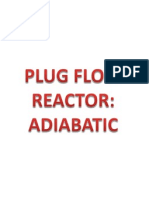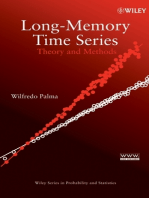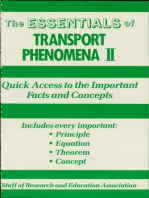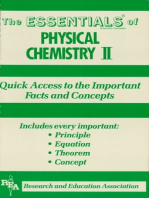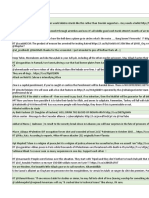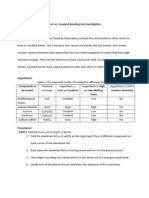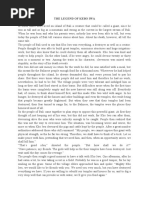Equilibrium in Solution: TPC TPRTC TPRT A TP
Equilibrium in Solution: TPC TPRTC TPRT A TP
Uploaded by
sgybleeCopyright:
Available Formats
Equilibrium in Solution: TPC TPRTC TPRT A TP
Equilibrium in Solution: TPC TPRTC TPRT A TP
Uploaded by
sgybleeOriginal Title
Copyright
Available Formats
Share this document
Did you find this document useful?
Is this content inappropriate?
Copyright:
Available Formats
Equilibrium in Solution: TPC TPRTC TPRT A TP
Equilibrium in Solution: TPC TPRTC TPRT A TP
Uploaded by
sgybleeCopyright:
Available Formats
5.
60 Spring 2008 Lecture #16 page
1
Equilibrium in Solution
The chemical potential for molecules in solution is given by a formula
that is very similar to that for ideal gases:
( ) ( ) ( ) | | = + = + , , , ln , ln
o o
A A A A A
T p c T p RT c T p RT A
The precise definition of the standard chemical potential ( ) ,
o
A
T p is
now more complicated; it is defined at a given pH, salt concentration,
etc, all solution properties that need to be defined in advance. We
will not go through those and take it as a given that the standard
state is appropriately defined.
Given a standard chemical potential ( ) ,
o
A
T p , then the analysis that
we did for the ideal gas follows straight through and we find for a
solution process
v
A
A(sol, T, p) + v
B
B(sol, T, p) = v
C
C(sol, T, p) + v
D
D(sol, T, p)
that following the ideal gas analysis in our previous lecture
( ) ( ) ( ) ( )
| | | |
| | | |
v v
v v
c c v v v v
| |
( ( A = + + + |
`
|
\ . )
o o o o
( ) ln
C D
B A
A A B B C C D D
C D
G T T T T RT
A B
and the equilibrium constant K comes out through
A = ln
o
rxn
G RT K ,
A
=
o
G RT
K e
Where
| | | |
| | | |
v v
v v
= =
C
B A
eq
C D
K Q
A B
D
at equilibrium as before, and where the
concentrations are equilibrium concentrations.
5.60 Spring 2008 Lecture #16 page
2
Temperature dependence of K (or K
p
)
( )
| | A A A
= = =
|
\ .
o o o
2
ln 1
ln
G d K d G G d
K T
RT dT dT RT RT RT dT
A
o
G
But at fixed pressure and/or solutions properties (p = 1 bar, pH
constant, etc..)
| | A cA
=
|
c
\ .
o o
1 bar,pH constant, etc...
d G G
dT T
and from fundamental equation
( )
o
o
p
p
G G
dG SdT Vdp S S T
T T
| | c cA
| |
= + = = A
| |
c c
\ .
\ .
( ) ( )
( )
A A
= +
o o
o
2
ln 1
H T T S T
d K
S T
dT RT RT
A
( ) ( ) A
=
o
2
ln d K T H T
dT RT
Integrating: ( ) ( )
( ) A
= +
}
2
1
o
2 1 2
ln ln
T
T
H T
K T K T dT
RT
At constant p: ( ) ( ) ( )
o o
1 1 p
H T H T C T T A = A + A
( ) ( )
( ) ( ) A + A
= +
}
2
1
o
1 1
2 1 2
ln ln
T
p
T
H T C T T
K T K T dT
RT
Over small T ranges, can be (
1 p
C T T A ) assumed small and
o
H A
independent of T.
( ) ( ) ( )
| | | A A
~ + = +
|
\ . \
o o
2 1
2 1 1
1 2 1 2
1 1
ln ln ln
T T H H
K T K T K T
R T T R TT
|
|
.
5.60 Spring 2008 Lecture #16 page
3
If ( ) ( ) ( )
o
2 1 2 1
0 (Exothermic) means
p p
H T T T K T K T A < > <
The equilibrium shifts toward reactants
If ( ) ( ) ( )
o
2 1 2 1
0 (Endothermic) means
p p
H T T T K T K T A > > >
The equilibrium shifts toward products
This is Le Chateliers principle for Temperature
- Example: The Haber process
N
2
(g, T, p) + 3/2 H
2
(g, T, p) = NH
3
(g, T, p)
( )
( )
o
o
298 K 46.21 kJ/mol
298 K 16.74 kJ/mol
rxn
rxn
H
G
A =
A =
( )( ) 3 3
2 2 2 2
16,740 J/mol
NH NH 8.314 J/K-mol 298 K 1
3 2 1 2 3 2 1 2
H H
860
p
N N
p X
K p e
p p X X
= = = =
For p = 1 bar this is pretty good, lots of product. However, the
reaction at room T is slow (this is kinetics, not thermodynamics).
Raising T to 800 K can speed it up. But since ( )
o
0 H T A < (exothermic),
Le Chatelier tells us that the equilibrium will shift toward the
reactants.
Indeed: ( ) 800 K 0.007
p
K =
What to do? Note above
p X
K p = K
5.60 Spring 2008 Lecture #16 page
4
Again use Le Chatelier, but with pressure! If we increase p, Eq.
shifts toward products.
Run reaction at high T and high p
For p = 1 bar, T = 800 K, K
p
= 0.007
( )
3
2 2
NH
3 2 1 2
H
1 0.007
p X
N
X
K K
X X
= = =
But at p = 100 bar, ( ) 100 0.7
p X
K K = = much better!
- Heterogeneous Equilibria
If a product or reactant is a solid or liquid, it will not appear in the
ratio of partial ps for K
p
or in the concentrations if the equilibrium is
in solution. However, it must be used in AG.
Why? Take v
A
A(s) + v
B
B(g) = v
C
C() + v
D
D(g)
The solid and liquid are not mixed they are pure states.
( ) ( ) ( ) ( s, pure, g, mix, , pure, g, mix,
A A B B C C D D
G p p p v v v v ( A = + +
l ) p (
And for () or (s) ( ) ( )
o
pure, pure
C
p ~ (no p-dependence)
o o o o o
ln ln
D
B
D
A A B B C C D D
B
p
G RT
p
v
v
v v v v A = + + = A + G RT Q
5.60 Spring 2008 Lecture #16 page
5
.
D
B
D
p
B
Eq
p
K
p
v
v
(
=
(
No A or C involved.
But we still have
o o o o
rxn A A B B C C D D
G
o
v v v v A = +
and
A
=
o
rxn
ln
p
G
K
RT
e.g. the decomposition of limestone
CaCO
3
(s) = CaO (s) + CO
2
(g) T = 25C
Calculate equilibrium vapor pressure at room T and elevated T.
Data at 25C:
Substance CaCO
3
(s) CaO (s) CO
2
(g)
o
(kJ/mol) -1128.8 -604.0 -394.36
A
o
f
H (kJ/mol) -1206.9 -635.09 -393.51
At equilibrium,
( ) ( ) ( )
( ) ( ) ( )
A = +
= + +
= A + =
2
2
2 3
o o o
CO 2 3
o
CO
CaO, s CO , g CaCO , s
CaO, s CO , g ln CaCO , s
ln where (at eq.)
p p
G
RT p
G RT K K p
The equilibrium constant includes only the gas, but includes
the solids too.
A
o
G
(kJ/mol) = -604.0 394.4 (-1128.8) = 130.4 kJ/mol A
o
G
(kJ/mol) = -635.1 393.5 (-1206.9) = 178.3 kJ/mol A
o
H
5.60 Spring 2008 Lecture #16 page
6
Equilibrium pressure:
( ) ( )
A
= = =
=
o
23
130, 400 J/mol
ln 52.50
8.314 J/K-mol 298.15 K
1.43 10 bar
p
p
G
K
RT
K x
Nothing there at room T ! Try 1100 K:
( ) ( )
( )
A
| |
~ +
|
\ .
| |
= =
|
\ .
~
2 2
2
o
CO CO
CO
1 1
ln 1100 K ln 298 K
1100 K 298 K
178, 300 J/mol 1 1
52.50 0.17
8.314 J/K-mol 1100 K 298 K
1100 K 0.84 bar
H
p p
R
p
Theres probably some change in A
o
f
H over such a wide T range,
but clearly the equilibrium shifts dramatically.
You might also like
- A Stepmother's MarchenDocument1,171 pagesA Stepmother's Marchengyorfiboroka73% (11)
- Thermodynamics (Prausnitz) Manual SolutionDocument195 pagesThermodynamics (Prausnitz) Manual SolutionColin Zhang78% (9)
- Managing Business Ethics: Prepared For Class Discussion by Prof.S.SuryanarayananDocument24 pagesManaging Business Ethics: Prepared For Class Discussion by Prof.S.SuryanarayananNic KnightNo ratings yet
- Chemical Equilibrium: Ideal GasesDocument6 pagesChemical Equilibrium: Ideal GasessgybleeNo ratings yet
- Departure FunctionDocument6 pagesDeparture FunctionzidinhoNo ratings yet
- 2 Plug Flow Reactor AdiabaticDocument33 pages2 Plug Flow Reactor Adiabaticbian_cool88No ratings yet
- 4-ITK-330 Steady State Nonisothermal Reactor DesignDocument37 pages4-ITK-330 Steady State Nonisothermal Reactor DesignadyckarockNo ratings yet
- Final Exam 2015Document6 pagesFinal Exam 2015Kiran JojiNo ratings yet
- 5.60 Thermodynamics & Kinetics: Mit OpencoursewareDocument7 pages5.60 Thermodynamics & Kinetics: Mit OpencoursewarecaptainhassNo ratings yet
- Nonideal Behavior: ITK-234 Termodinamika Teknik Kimia IIDocument65 pagesNonideal Behavior: ITK-234 Termodinamika Teknik Kimia IIAdhiaRieyanasariNo ratings yet
- HW7 AnswerDocument17 pagesHW7 AnswerAriel Wang0% (1)
- TER201 Lecture 6Document66 pagesTER201 Lecture 6lnxxNo ratings yet
- Reacting Mixtures and CombustionDocument23 pagesReacting Mixtures and CombustionDeepti KanadeNo ratings yet
- Chemical Engineering 301 Lecture Notes: (Revised 9/04)Document9 pagesChemical Engineering 301 Lecture Notes: (Revised 9/04)shiv kr dubeyNo ratings yet
- Chemical EquilibriumDocument6 pagesChemical Equilibriumlmcristina5No ratings yet
- Chapter 06Document26 pagesChapter 06Ramakrishna KoushikNo ratings yet
- Multicomponent Systems, Partial Molar Quantities, and The Chemical PotentialDocument5 pagesMulticomponent Systems, Partial Molar Quantities, and The Chemical PotentialsgybleeNo ratings yet
- Solutions Set 5 AtkinsDocument18 pagesSolutions Set 5 AtkinsSakinah Himav RezeikaNo ratings yet
- Second Semester Stage 2Document99 pagesSecond Semester Stage 2Watch DogsNo ratings yet
- Chapter 3 - Section B - Non-Numerical SolutionsDocument10 pagesChapter 3 - Section B - Non-Numerical SolutionsFaris NaufalNo ratings yet
- Chapter 3 - Section B - Non-Numerical SolutionsDocument12 pagesChapter 3 - Section B - Non-Numerical Solutionslight2618No ratings yet
- Steady State Non Iso Thermal Reactor DesignDocument37 pagesSteady State Non Iso Thermal Reactor Designmohamadi42No ratings yet
- CH 11Document22 pagesCH 11Ingenio MetalurgiaNo ratings yet
- Other Thermodynamic Relations: Real Gas Behavior & Equations of StateDocument10 pagesOther Thermodynamic Relations: Real Gas Behavior & Equations of StateJamesBanglaganNo ratings yet
- Final Exam StuffDocument12 pagesFinal Exam StuffjunusubsubNo ratings yet
- Applications: Chemical and Phase Equilibria: 5.60 Spring 2008 Lecture #29Document6 pagesApplications: Chemical and Phase Equilibria: 5.60 Spring 2008 Lecture #29sgybleeNo ratings yet
- Chapter 6 - Section B - Non-Numerical Solutions: 6.1 by Eq. (6.8)Document7 pagesChapter 6 - Section B - Non-Numerical Solutions: 6.1 by Eq. (6.8)Faris NaufalNo ratings yet
- Assigment1 SolDocument5 pagesAssigment1 SolMahmood SamadpoorNo ratings yet
- General Chemistry Lecturer-2Document34 pagesGeneral Chemistry Lecturer-2Bảo Long Trần LêNo ratings yet
- Principles of Chemical Equilibrium: BG BGDocument30 pagesPrinciples of Chemical Equilibrium: BG BGJudith Del Valle MorejonNo ratings yet
- Second Law of Thermodynamics: T T Q QDocument10 pagesSecond Law of Thermodynamics: T T Q Qnellai kumarNo ratings yet
- 5.60 Thermodynamics & Kinetics: Mit OpencoursewareDocument7 pages5.60 Thermodynamics & Kinetics: Mit OpencoursewarecaptainhassNo ratings yet
- Chapter 15: Chemical and Phase Equilibrium: CH O N DCO ECO FO GHO BNDocument0 pagesChapter 15: Chemical and Phase Equilibrium: CH O N DCO ECO FO GHO BNAlex Samuel SilvaNo ratings yet
- Begin With A Brief Review of Chapter 5: ThermodynamicsDocument39 pagesBegin With A Brief Review of Chapter 5: ThermodynamicsBenudhar PradhanNo ratings yet
- Volumetric Properties of Pure FluidsDocument21 pagesVolumetric Properties of Pure FluidsIR Ika EtyEtyka Dora100% (1)
- Fixed Bed ReactorDocument43 pagesFixed Bed ReactorMaher Al-busaidi100% (2)
- Week 2. Chemical Kinetics Analysis of Rate EquationDocument31 pagesWeek 2. Chemical Kinetics Analysis of Rate EquationYuni ApriyaniNo ratings yet
- Properties of Pure MaterialsDocument18 pagesProperties of Pure MaterialsDaniel Casas-OrozcoNo ratings yet
- Fixed Bed Reactor, Modelling&Optimal DesignDocument74 pagesFixed Bed Reactor, Modelling&Optimal DesignRana Uzair100% (1)
- X. Reactions x.1 Order of Reactions x.1.01 Zero Order ReactionsDocument28 pagesX. Reactions x.1 Order of Reactions x.1.01 Zero Order ReactionsJon Bisu DebnathNo ratings yet
- Chapter 3Document81 pagesChapter 3Jasmine Jones92% (37)
- Entropy ChangeDocument13 pagesEntropy Changeنبيل محمد عيد ابوميراNo ratings yet
- Chemical Reactions: 4-Thermodynamics - S11Document18 pagesChemical Reactions: 4-Thermodynamics - S11Jon Bisu DebnathNo ratings yet
- Chapter 13Document46 pagesChapter 13Khloud MadihNo ratings yet
- Isothermal ReactorDocument58 pagesIsothermal ReactorRoxanna Levine100% (1)
- VALEM2Document1 pageVALEM2Hans PriksNo ratings yet
- 10+2 Level Mathematics For All Exams GMAT, GRE, CAT, SAT, ACT, IIT JEE, WBJEE, ISI, CMI, RMO, INMO, KVPY Etc.From Everand10+2 Level Mathematics For All Exams GMAT, GRE, CAT, SAT, ACT, IIT JEE, WBJEE, ISI, CMI, RMO, INMO, KVPY Etc.No ratings yet
- A Modern Course in Statistical PhysicsFrom EverandA Modern Course in Statistical PhysicsRating: 3.5 out of 5 stars3.5/5 (2)
- Simple Algebras, Base Change, and the Advanced Theory of the Trace FormulaFrom EverandSimple Algebras, Base Change, and the Advanced Theory of the Trace FormulaNo ratings yet
- Instructions For The EssayDocument1 pageInstructions For The EssaysgybleeNo ratings yet
- The Postulates of Quantum Mechanics: Postulate 1Document6 pagesThe Postulates of Quantum Mechanics: Postulate 1sgybleeNo ratings yet
- MAPK Signaling PathwayDocument2 pagesMAPK Signaling PathwaysgybleeNo ratings yet
- Equilibrium: Application To Drug Design: Nature BiotechnologyDocument5 pagesEquilibrium: Application To Drug Design: Nature BiotechnologysgybleeNo ratings yet
- Complex Reactions and Mechanisms (Continued)Document7 pagesComplex Reactions and Mechanisms (Continued)sgybleeNo ratings yet
- 5 60 Lecture23Document4 pages5 60 Lecture23sgybleeNo ratings yet
- Multicomponent Systems, Partial Molar Quantities, and The Chemical PotentialDocument5 pagesMulticomponent Systems, Partial Molar Quantities, and The Chemical PotentialsgybleeNo ratings yet
- Model Systems: Double-Stranded Polymer ModelDocument7 pagesModel Systems: Double-Stranded Polymer ModelsgybleeNo ratings yet
- Applications: Chemical and Phase Equilibria: 5.60 Spring 2008 Lecture #29Document6 pagesApplications: Chemical and Phase Equilibria: 5.60 Spring 2008 Lecture #29sgybleeNo ratings yet
- Two-Component Phase Equilibria III Ideal and Non-Ideal SolutionsDocument6 pagesTwo-Component Phase Equilibria III Ideal and Non-Ideal SolutionssgybleeNo ratings yet
- Emil Strings VerDocument5 pagesEmil Strings VersgybleeNo ratings yet
- Kinetics: Reaction Rates, Orders, Half Lives: Aa + BB CC + DDDocument8 pagesKinetics: Reaction Rates, Orders, Half Lives: Aa + BB CC + DDsgyblee100% (1)
- MAPK Signaling PathwayDocument2 pagesMAPK Signaling PathwaysgybleeNo ratings yet
- Waltz For AriahDocument8 pagesWaltz For AriahsgybleeNo ratings yet
- Course Syllabus: Course Code: Course Title: Credit: Time DurationDocument3 pagesCourse Syllabus: Course Code: Course Title: Credit: Time DurationJonalyn ObinaNo ratings yet
- (Adrpg) Castle Amber's Abyss PowerDocument4 pages(Adrpg) Castle Amber's Abyss PowerWill HarperNo ratings yet
- Bai Tap NG ÂmDocument3 pagesBai Tap NG Âm2007010204No ratings yet
- 5 Extreme Sports You Need To TryDocument4 pages5 Extreme Sports You Need To Trymeysareh.shabarariNo ratings yet
- LESSON 3 Patterns of Text Development (Shortened)Document40 pagesLESSON 3 Patterns of Text Development (Shortened)Elijah OrdoñezNo ratings yet
- Siltala - A Theory of PrecedentDocument304 pagesSiltala - A Theory of PrecedentLeticia Santini0% (1)
- Islamiat Mcq's For PPSCDocument14 pagesIslamiat Mcq's For PPSCmksaifi736No ratings yet
- Financial Derivatives InstrumentDocument18 pagesFinancial Derivatives InstrumentAfreen Redita100% (1)
- Zeta Macedonia: Vermont, USADocument3 pagesZeta Macedonia: Vermont, USAwaleexasNo ratings yet
- Zen - The Wayless WayDocument140 pagesZen - The Wayless WayAbigail Doromal Albino90% (10)
- En Todos Idiom AsDocument1,182 pagesEn Todos Idiom AsJuan Pablo Betancur CórdobaNo ratings yet
- The Wheel of WellnessDocument3 pagesThe Wheel of WellnessLeighsen VillacortaNo ratings yet
- Discourse Analysis - Be Careful With My Heart PDFDocument2 pagesDiscourse Analysis - Be Careful With My Heart PDFMic VillamayorNo ratings yet
- Sample Motion To Reset HearingDocument3 pagesSample Motion To Reset HearingChow GalanNo ratings yet
- Chapter - 04 Opportunity Analysis, Market Segmentation, Market TargetingDocument25 pagesChapter - 04 Opportunity Analysis, Market Segmentation, Market TargetingKJ VillNo ratings yet
- Wilhelm Reich, M.D. Microfilm Collection - Table of ContentsDocument14 pagesWilhelm Reich, M.D. Microfilm Collection - Table of ContentsWilhelm Reich Ghost100% (3)
- ZenjjfnkfbnkbjDocument4 pagesZenjjfnkfbnkbjnwigubesanityNo ratings yet
- Ionic vs. Covalent Bonding Lab InvestigationDocument3 pagesIonic vs. Covalent Bonding Lab InvestigationLeslieNo ratings yet
- The Legend of Kebo IwaDocument2 pagesThe Legend of Kebo IwaKhrisna AblehNo ratings yet
- The Merchant of Venice SUMMARYDocument26 pagesThe Merchant of Venice SUMMARYDeh TavernitiNo ratings yet
- Equal Employment v. BCI Coca-Cola, 450 F.3d 476, 10th Cir. (2006)Document36 pagesEqual Employment v. BCI Coca-Cola, 450 F.3d 476, 10th Cir. (2006)Scribd Government DocsNo ratings yet
- Mapeh Health 2 QTRDocument9 pagesMapeh Health 2 QTRRichard HernandezNo ratings yet
- Shape FuncDocument33 pagesShape FuncSAMNo ratings yet
- Final Fccla SLC Lesson PlansDocument80 pagesFinal Fccla SLC Lesson PlansleongkcNo ratings yet
- Global MBA BrochureDocument36 pagesGlobal MBA Brochureveda20No ratings yet
- Region 11 - REPORTDocument3 pagesRegion 11 - REPORTecca998No ratings yet
- Sarah Curtis 2b Homework PaperDocument4 pagesSarah Curtis 2b Homework Paperapi-288183886No ratings yet
- The Effect of Music On Plant GrowthDocument10 pagesThe Effect of Music On Plant Growthadityachakrabor639875% (4)






